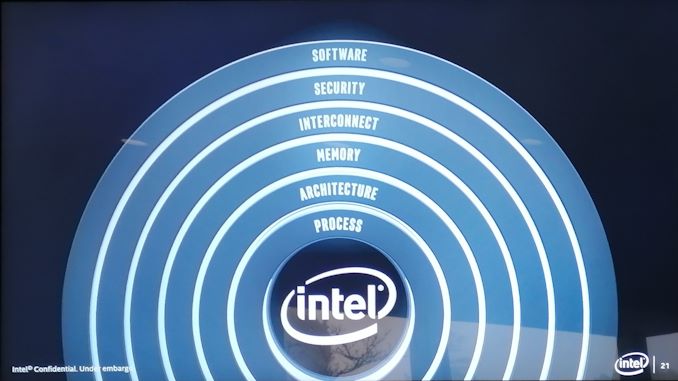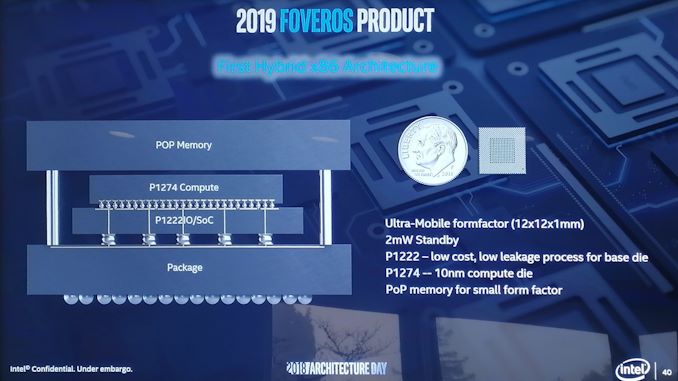Intel's Architecture Day 2018: The Future of Core, Intel GPUs, 10nm, and Hybrid x86
by Dr. Ian Cutress on December 12, 2018 9:00 AM EST- Posted in
- CPUs
- Memory
- Intel
- GPUs
- DRAM
- Architecture
- Microarchitecture
- Xe
Intel Made Something Really Funny
Q&A with Raja, Jim, and Murthy
Through Intel’s Architecture Day, the company did a couple of side discussions for a few journalists to speak to Raja Koduri and Jim Keller in a round-table format. Beyond that, Murthy Renduchintala and Raja also held a Q&A session at the end of the day. They answered questions on 10nm, the new Foveros technology, Thunderbolt 3 adoption, and how Intel will approach 5G.
For this article, the Questions and Answers will be listed as an abridged version of the responses, due to time constraints and live transcription, with questions grouped based on topic. Different members of the press asked these questions.
Q: A lot of the CPU microarchitecture at Intel has been hamstrung by delays on process node technology. What went wrong, and what steps have been made to make sure it doesn't happen again?
R/J: Our products will be decoupled from our transistor capability. We have incredible IP at Intel, but it was all sitting in the 10nm process node. If we had had it on 14nm then we would have better performance on 14nm. We have a new method inside the company to decouple IP from the process technology. You must remember that customers buy the product, not a transistor family. It’s the same transformation AMD had to go through to change the design methodology when they were struggling. At Apple it was called the ‘bus’ method.
M: This is a function of how we as a company used to think about process node technologies. It was a frame tick (limiting factor) for how the company moved forward. We've learned a lot about how this worked with 14nm. We now have to make sure that our IP is not node-locked. The ability to have portability of IP across multiple nodes is great for contingency planning. We will continue to take aggressive risks in our designs, but we also will have contingency. We need to have as much of a seamless roadmap as possible in case those contingencies are needed, and need to make sure they are executed on ASAP if needed to keep the customer expectations in line. You will see future node technologies, such as 10/7, have much more overlap than before to keep the designs fluid. Our product portfolio on 14nm could have been much better if our product designs were not node-locked to 10nm.
R: In the future there will be no transistor left behind, no customer left behind, and no IP left behind.
Q: Will we ever see a 10nm monolithic desktop CPU at the high end?
R: Yes.
Q: How is 10nm? Has it changed?
R: It is changing, but it hasn't changed. There are a lot of lessons learned in how Intel approached it to begin with. We are established a much better model between manufacturing and design. We want good abstractions in product and process node going forward. When everything was going well, this issue didn't manifest and so wasn't an issue. There's complexity here when something bad happens on process, so the whole pipeline clogs up - the rest of the world solves this with abstraction. We need to make sure it won't happen again, and we have a desire to build resilience in the roadmap.
Q: Are there plans for mixed SoCs, combining CPU / GPU / AI / FPGA ?
R: In our roadmap there will be scalable vector/matrix combinations. What our customers want are very scalable solutions. Customers want similar programming models regardless of the silicon.
Q: What has been the effect of hiring Raja/Jim and bringing outsiders to Intel?
M: Intel is very innovative. We want to add to that chemistry and make sure we bring in people who understand Intel but also bring in good ideas. It's about respecting the rest of the market and make sure Intel is competitive. It's balancing the centre of internal debates by making sure we are challenging internal beliefs and the status quo by bringing in people who have done this sort of thing before. It shows to Intel's strengths in its ability to absorb interesting ideas from the outside. We went for the very best on the outside because that was what required to join with the very best on inside.
Q: What is Intel’s current approach to 5G, given the topics discussed today?
M: We think about 5G from the datacentre to the network to the edge and to the device. We at Intel believe the transition to 5G and its implications on the network, in terms of accelerating data and catalysing a software defined network where bespoke silicon gets replaced by containers, is as transformative as the jump from analogue to digital. It will accelerate the ‘cloudification’ of the network. The edge is important, especially to minimize latency for new services. Sub-millisecond latency for these services is critical. The over-the-air interface is important too. The intelligent cloud domain is going to be the flywheel about how fast the industry evolves. We mentioned in November that our XMM 5G modem will be in the hands of partners in the second half of 2019 with products in early 2020. It is a multi-mode 5G LTE architecture from day one, supporting all 3 mmWave bands, and sub-6 GHz frequencies.
Q: As Thunderbolt 3 requires additional chips, how do you see future OEM adoption?
M: Integrated Type-C Thunderbolt 3 is the first generation. We will refine it in the future - that's the natural genealogy of the technology. We constantly think about how much we integrate into the chip and how much we leave on the board.
R: This is a big IP challenge, not only for TB3, but for other IP. Integrated PHYs are important. For example, by disaggregating the transceiver in our FPGA line-up, it has allowed us to focus on that decoupled IP a lot.
Q: In the demo of FOVEROS, the chip combined both big x86 cores built on the Core microarchitecture and the small x86 cores built on the Atom microarchitecture. Can we look forward to a future where the big and little cores have the same ISA?
R: We are working on that. Do they have to have the same ISA? Ronak and the team are looking at that. However I think our goal here is to keep the software as simple as possible for developers and customers. It's a challenge that our architects have taken up to ensure products like this enter the market smoothly. We’ll also have a packaging discussion next year on products like this. The chip you see today, while it was designed primarily for a particular customer to begin with, it’s not a custom product, and in that sense will be available to other OEMs.
M: We've made the first step on a journey. That first step is a leap, and the next step is incremental. As we've said about One API strategy – if we homogenise the API then it'll go into all our CPUs. FOVEROS is also a new part/product that shows that we had a gap in our portfolio – it has helped us create technologies to solve an issue and we expect to expand on this in the future with new IP.
Q: Are you having fun with FOVEROS?
J: Because Raja deals in GPUs, he’s having fun with high bandwidth communications between compute elements. It's a new technology and we're having some experimentation with it. What is frustrating is that as an industry we hit a limit for current flux density a year before stacking technology became viable, so for high performance on stacking we're trying a lot of things in different areas. There's no point having to make thermal setbacks if it also removes the reason why you're using the technology. But we're having fun and trying a lot, and we'll see FOVEROS in a number of parts over the next 5 years. We will find new solutions to problems we don't even know exist yet.
Q: When is Manufacturing Tech Day?
M: We will tell you when it happens! I'm sure you all have opinions on Intel 10nm right now and yes we are looking at what we're doing, eating an amount of humble pie, but we're re-adjusting our process to make sure that we can take the best process no matter what the product is.
The title of this page was a quote from Jim during the Q&A: 'At some point in the future you'll read an article with the title Intel Made Something Really Funny.'. I think I win this bet...

















148 Comments
View All Comments
zodiacfml - Thursday, December 13, 2018 - link
YESRaqia - Thursday, December 13, 2018 - link
For ultra-mobile, not only are battery/power/heat issues but supply is one as well due to Intel being locked down to their own manufacturing division. On top of that, they have a lock on x86 by not licensing to any competitors but AMD, who despite competitive stretches inevitably stumbles (either due to themselves or Intel's non-engineering financial efforts) and leaves the industry with dry spells of performance improvements. Intel's gross margins on their chips remain >60% as a result whereas ARM SoCs even after licensing is closer to 20-30%.Raqia - Thursday, December 13, 2018 - link
Keller declared that the technology is in its infancy, and feature wise the 2019 version of the Atom simply won't be competitive with leading ARM SoCs like the 8cx. The slowness you refer to only occurs when running native 32 bit x86 code on the WOW emulation layer, but the value of this feature is mostly in the compatibility being there at all. If performance and compatibility of legacy code matters to you then certainly Windows on Arm isn't suitable. However, it will matter even less now with the new native compilation tools and ports of important sub platforms like Chromium.29a - Thursday, December 13, 2018 - link
"Windows on ARM is horribly slow and therefore shitty."Sounds a lot like Windows on Atom.
MonkeyPaw - Saturday, December 15, 2018 - link
I’m betting Apple wanted one for MacBook Air, or maybe MS for Surface Go. It would be the right amount of performance for both devices, an both companies would have the clout to get it done. I’d lean toward Apple because the GPU is pretty big.Kevin G - Wednesday, December 12, 2018 - link
Typo:"a physical address space up to 52 bits. This means, according to Intel, that the server processors could theoretically support 4 TB of memory per socket."
That should be petabytes instead of terabytes. The limit is for an entire system, not per socket as additional sockets will not grant any additional capacity.
gamerk2 - Thursday, December 13, 2018 - link
NUMA systems could potentially be per-socket rather then OS wide.HStewart - Wednesday, December 12, 2018 - link
It sounds like Intel has been working on increasing performance in two ways1. 7nm change for the future - because of limitations found with 10nm
2. 10nm enhance for corrections for performance of issues with Cannon Lake
But most importantly, architexture improvements like faster single thread execution and new instructions and multi-core improvements will in long term significantly improve performance
ishould - Wednesday, December 12, 2018 - link
Forgive me if I take 2 metric tons of salt with any roadmaps Intel provides these days. They haven't exactly had the most accurate timelines as of late (past four years)HStewart - Wednesday, December 12, 2018 - link
It appears they realize that and coming out with document to indicated they have made corrections - this is better than not knowing what they are planning - or as some AMD Fans would like to believe that they lost the battle.